Rhetorical Analysis of “Rethinking School Discipline” by Rachel Cohen
VerifiedAdded on 2022/10/10
|6
|1491
|54
AI Summary
This paper is a rhetorical analysis of Rachel Cohen’s “Rethinking School Discipline.” The author targets the both the general and education stakeholders to inform and persuade respectively. The paper analyzes the claim, ground, warrant, backing, qualifier and rebuttal of the article. The author argues that the current policy on discipline is the major cause for the “school-to-prison pipeline” that unduly targets students of color and Hispanics. The author suggests that a new paradigm is needed to ensure that school discipline is restorative and not punitive.
Contribute Materials
Your contribution can guide someone’s learning journey. Share your
documents today.
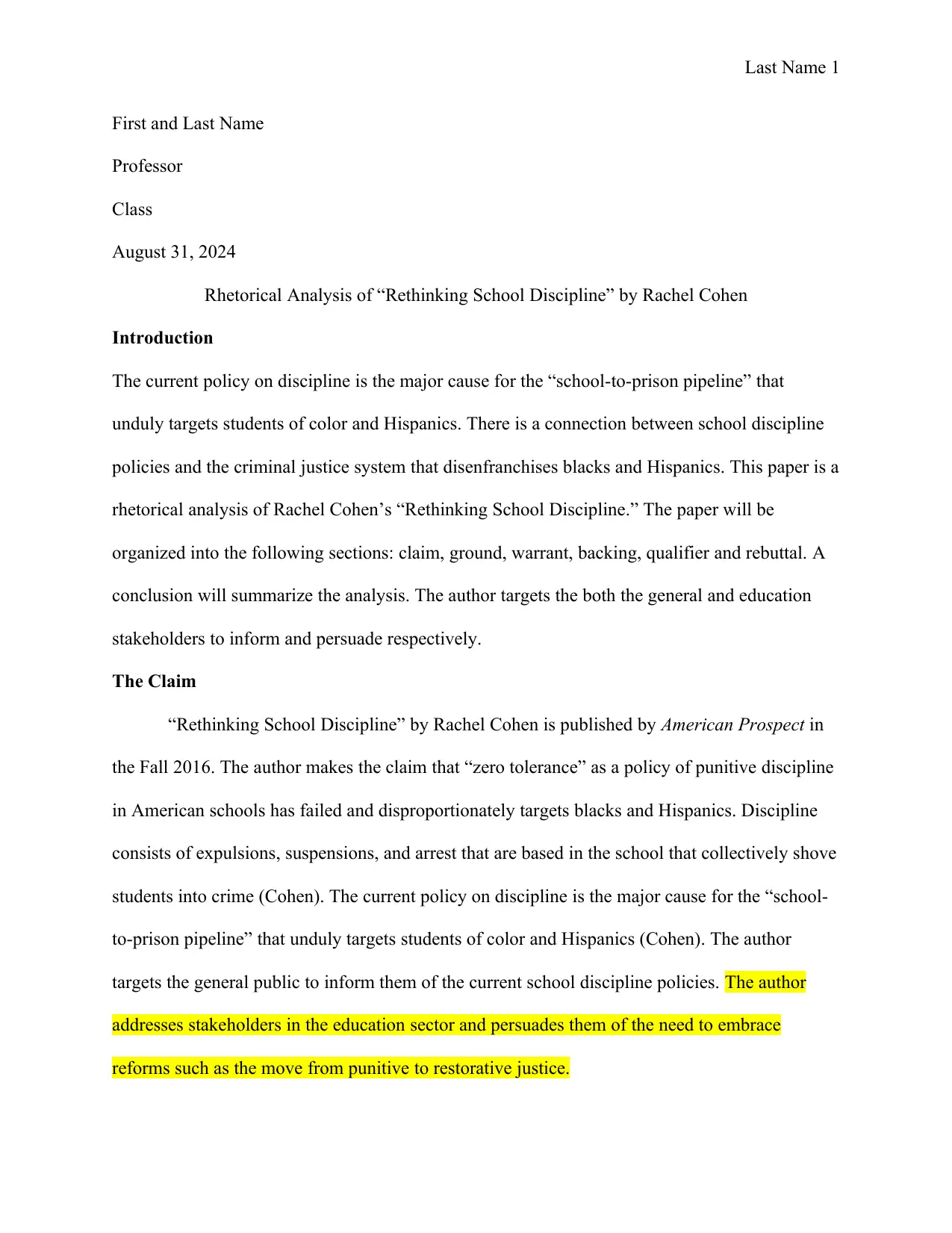
Last Name 1
First and Last Name
Professor
Class
August 31, 2024
Rhetorical Analysis of “Rethinking School Discipline” by Rachel Cohen
Introduction
The current policy on discipline is the major cause for the “school-to-prison pipeline” that
unduly targets students of color and Hispanics. There is a connection between school discipline
policies and the criminal justice system that disenfranchises blacks and Hispanics. This paper is a
rhetorical analysis of Rachel Cohen’s “Rethinking School Discipline.” The paper will be
organized into the following sections: claim, ground, warrant, backing, qualifier and rebuttal. A
conclusion will summarize the analysis. The author targets the both the general and education
stakeholders to inform and persuade respectively.
The Claim
“Rethinking School Discipline” by Rachel Cohen is published by American Prospect in
the Fall 2016. The author makes the claim that “zero tolerance” as a policy of punitive discipline
in American schools has failed and disproportionately targets blacks and Hispanics. Discipline
consists of expulsions, suspensions, and arrest that are based in the school that collectively shove
students into crime (Cohen). The current policy on discipline is the major cause for the “school-
to-prison pipeline” that unduly targets students of color and Hispanics (Cohen). The author
targets the general public to inform them of the current school discipline policies. The author
addresses stakeholders in the education sector and persuades them of the need to embrace
reforms such as the move from punitive to restorative justice.
First and Last Name
Professor
Class
August 31, 2024
Rhetorical Analysis of “Rethinking School Discipline” by Rachel Cohen
Introduction
The current policy on discipline is the major cause for the “school-to-prison pipeline” that
unduly targets students of color and Hispanics. There is a connection between school discipline
policies and the criminal justice system that disenfranchises blacks and Hispanics. This paper is a
rhetorical analysis of Rachel Cohen’s “Rethinking School Discipline.” The paper will be
organized into the following sections: claim, ground, warrant, backing, qualifier and rebuttal. A
conclusion will summarize the analysis. The author targets the both the general and education
stakeholders to inform and persuade respectively.
The Claim
“Rethinking School Discipline” by Rachel Cohen is published by American Prospect in
the Fall 2016. The author makes the claim that “zero tolerance” as a policy of punitive discipline
in American schools has failed and disproportionately targets blacks and Hispanics. Discipline
consists of expulsions, suspensions, and arrest that are based in the school that collectively shove
students into crime (Cohen). The current policy on discipline is the major cause for the “school-
to-prison pipeline” that unduly targets students of color and Hispanics (Cohen). The author
targets the general public to inform them of the current school discipline policies. The author
addresses stakeholders in the education sector and persuades them of the need to embrace
reforms such as the move from punitive to restorative justice.
Secure Best Marks with AI Grader
Need help grading? Try our AI Grader for instant feedback on your assignments.
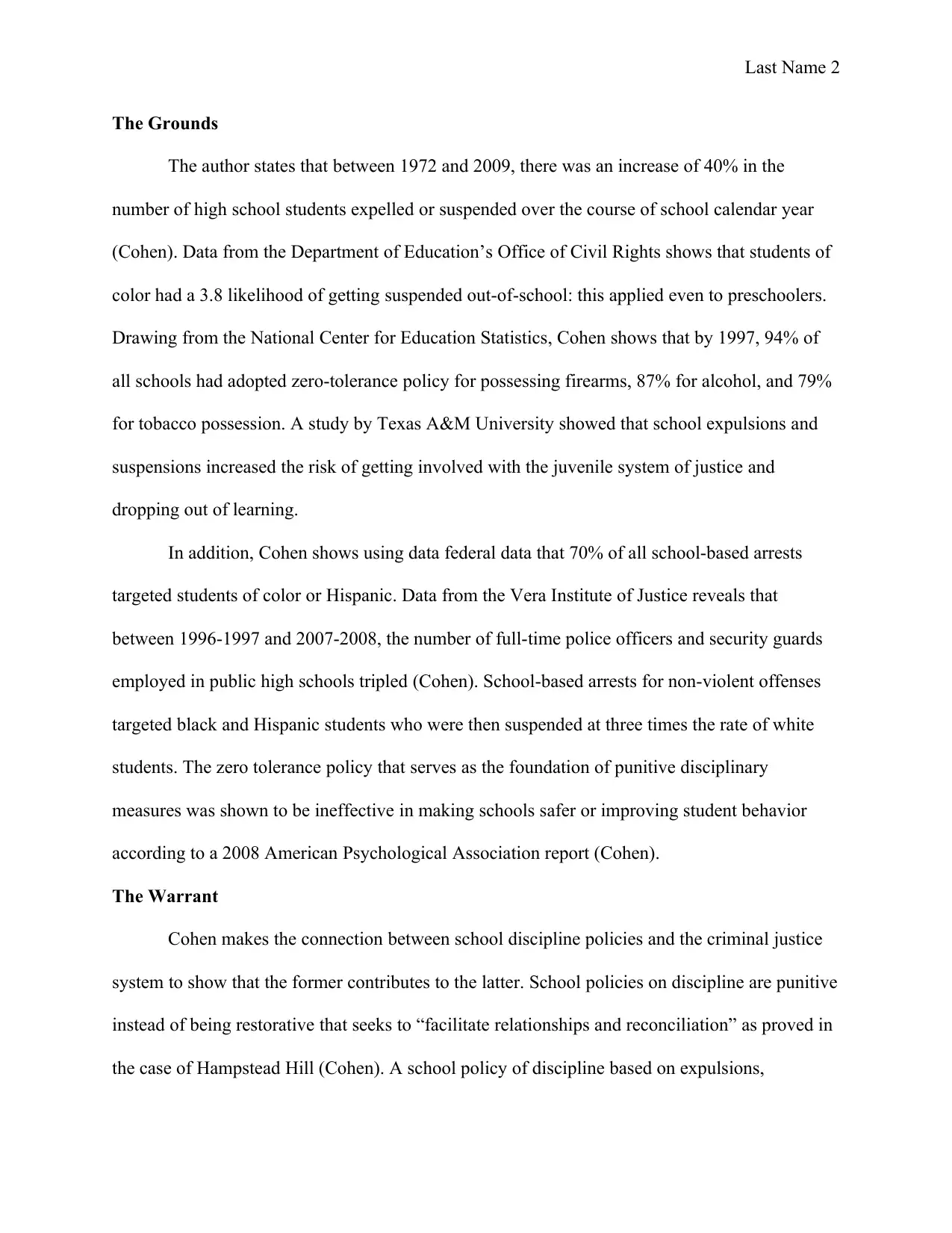
Last Name 2
The Grounds
The author states that between 1972 and 2009, there was an increase of 40% in the
number of high school students expelled or suspended over the course of school calendar year
(Cohen). Data from the Department of Education’s Office of Civil Rights shows that students of
color had a 3.8 likelihood of getting suspended out-of-school: this applied even to preschoolers.
Drawing from the National Center for Education Statistics, Cohen shows that by 1997, 94% of
all schools had adopted zero-tolerance policy for possessing firearms, 87% for alcohol, and 79%
for tobacco possession. A study by Texas A&M University showed that school expulsions and
suspensions increased the risk of getting involved with the juvenile system of justice and
dropping out of learning.
In addition, Cohen shows using data federal data that 70% of all school-based arrests
targeted students of color or Hispanic. Data from the Vera Institute of Justice reveals that
between 1996-1997 and 2007-2008, the number of full-time police officers and security guards
employed in public high schools tripled (Cohen). School-based arrests for non-violent offenses
targeted black and Hispanic students who were then suspended at three times the rate of white
students. The zero tolerance policy that serves as the foundation of punitive disciplinary
measures was shown to be ineffective in making schools safer or improving student behavior
according to a 2008 American Psychological Association report (Cohen).
The Warrant
Cohen makes the connection between school discipline policies and the criminal justice
system to show that the former contributes to the latter. School policies on discipline are punitive
instead of being restorative that seeks to “facilitate relationships and reconciliation” as proved in
the case of Hampstead Hill (Cohen). A school policy of discipline based on expulsions,
The Grounds
The author states that between 1972 and 2009, there was an increase of 40% in the
number of high school students expelled or suspended over the course of school calendar year
(Cohen). Data from the Department of Education’s Office of Civil Rights shows that students of
color had a 3.8 likelihood of getting suspended out-of-school: this applied even to preschoolers.
Drawing from the National Center for Education Statistics, Cohen shows that by 1997, 94% of
all schools had adopted zero-tolerance policy for possessing firearms, 87% for alcohol, and 79%
for tobacco possession. A study by Texas A&M University showed that school expulsions and
suspensions increased the risk of getting involved with the juvenile system of justice and
dropping out of learning.
In addition, Cohen shows using data federal data that 70% of all school-based arrests
targeted students of color or Hispanic. Data from the Vera Institute of Justice reveals that
between 1996-1997 and 2007-2008, the number of full-time police officers and security guards
employed in public high schools tripled (Cohen). School-based arrests for non-violent offenses
targeted black and Hispanic students who were then suspended at three times the rate of white
students. The zero tolerance policy that serves as the foundation of punitive disciplinary
measures was shown to be ineffective in making schools safer or improving student behavior
according to a 2008 American Psychological Association report (Cohen).
The Warrant
Cohen makes the connection between school discipline policies and the criminal justice
system to show that the former contributes to the latter. School policies on discipline are punitive
instead of being restorative that seeks to “facilitate relationships and reconciliation” as proved in
the case of Hampstead Hill (Cohen). A school policy of discipline based on expulsions,
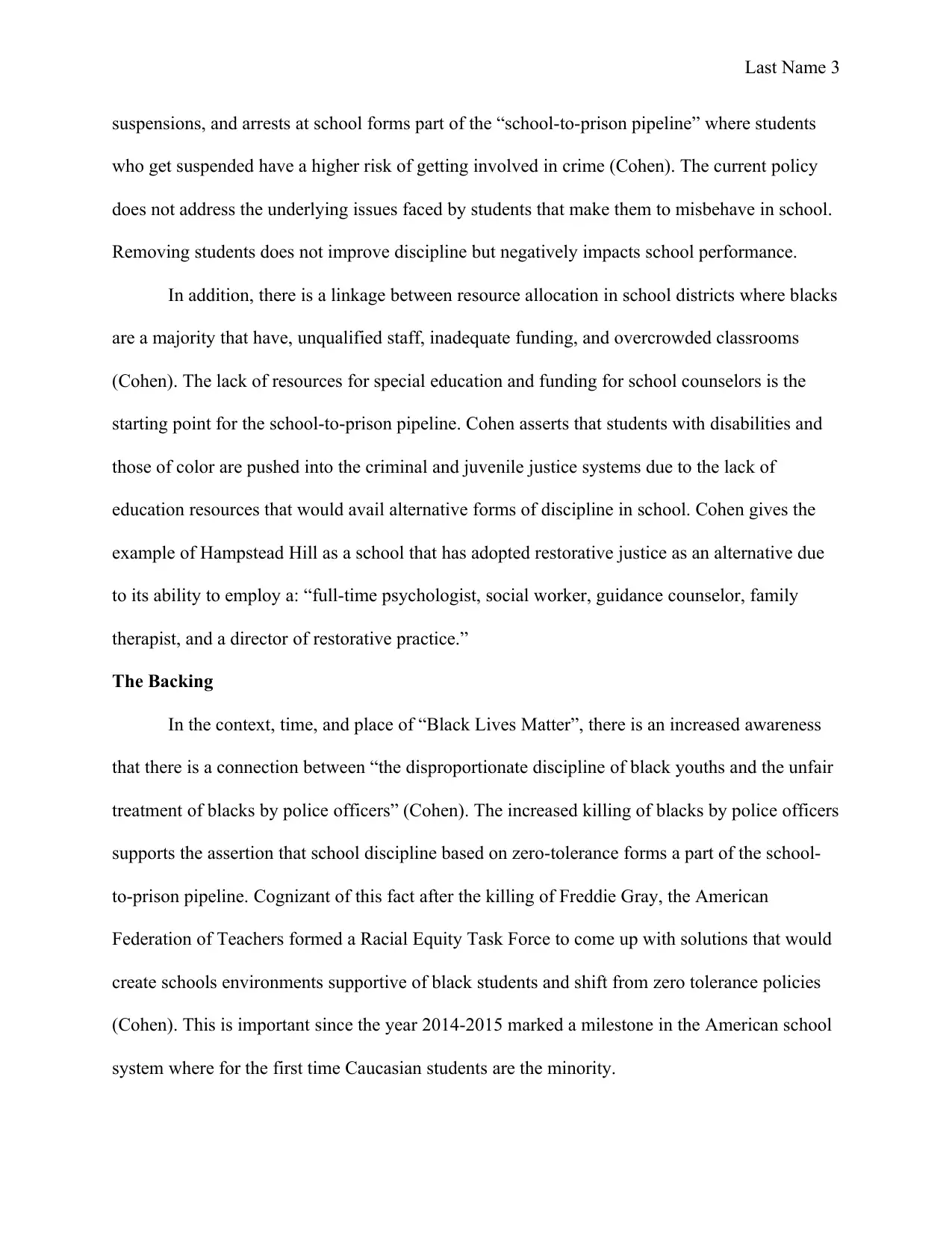
Last Name 3
suspensions, and arrests at school forms part of the “school-to-prison pipeline” where students
who get suspended have a higher risk of getting involved in crime (Cohen). The current policy
does not address the underlying issues faced by students that make them to misbehave in school.
Removing students does not improve discipline but negatively impacts school performance.
In addition, there is a linkage between resource allocation in school districts where blacks
are a majority that have, unqualified staff, inadequate funding, and overcrowded classrooms
(Cohen). The lack of resources for special education and funding for school counselors is the
starting point for the school-to-prison pipeline. Cohen asserts that students with disabilities and
those of color are pushed into the criminal and juvenile justice systems due to the lack of
education resources that would avail alternative forms of discipline in school. Cohen gives the
example of Hampstead Hill as a school that has adopted restorative justice as an alternative due
to its ability to employ a: “full-time psychologist, social worker, guidance counselor, family
therapist, and a director of restorative practice.”
The Backing
In the context, time, and place of “Black Lives Matter”, there is an increased awareness
that there is a connection between “the disproportionate discipline of black youths and the unfair
treatment of blacks by police officers” (Cohen). The increased killing of blacks by police officers
supports the assertion that school discipline based on zero-tolerance forms a part of the school-
to-prison pipeline. Cognizant of this fact after the killing of Freddie Gray, the American
Federation of Teachers formed a Racial Equity Task Force to come up with solutions that would
create schools environments supportive of black students and shift from zero tolerance policies
(Cohen). This is important since the year 2014-2015 marked a milestone in the American school
system where for the first time Caucasian students are the minority.
suspensions, and arrests at school forms part of the “school-to-prison pipeline” where students
who get suspended have a higher risk of getting involved in crime (Cohen). The current policy
does not address the underlying issues faced by students that make them to misbehave in school.
Removing students does not improve discipline but negatively impacts school performance.
In addition, there is a linkage between resource allocation in school districts where blacks
are a majority that have, unqualified staff, inadequate funding, and overcrowded classrooms
(Cohen). The lack of resources for special education and funding for school counselors is the
starting point for the school-to-prison pipeline. Cohen asserts that students with disabilities and
those of color are pushed into the criminal and juvenile justice systems due to the lack of
education resources that would avail alternative forms of discipline in school. Cohen gives the
example of Hampstead Hill as a school that has adopted restorative justice as an alternative due
to its ability to employ a: “full-time psychologist, social worker, guidance counselor, family
therapist, and a director of restorative practice.”
The Backing
In the context, time, and place of “Black Lives Matter”, there is an increased awareness
that there is a connection between “the disproportionate discipline of black youths and the unfair
treatment of blacks by police officers” (Cohen). The increased killing of blacks by police officers
supports the assertion that school discipline based on zero-tolerance forms a part of the school-
to-prison pipeline. Cognizant of this fact after the killing of Freddie Gray, the American
Federation of Teachers formed a Racial Equity Task Force to come up with solutions that would
create schools environments supportive of black students and shift from zero tolerance policies
(Cohen). This is important since the year 2014-2015 marked a milestone in the American school
system where for the first time Caucasian students are the minority.
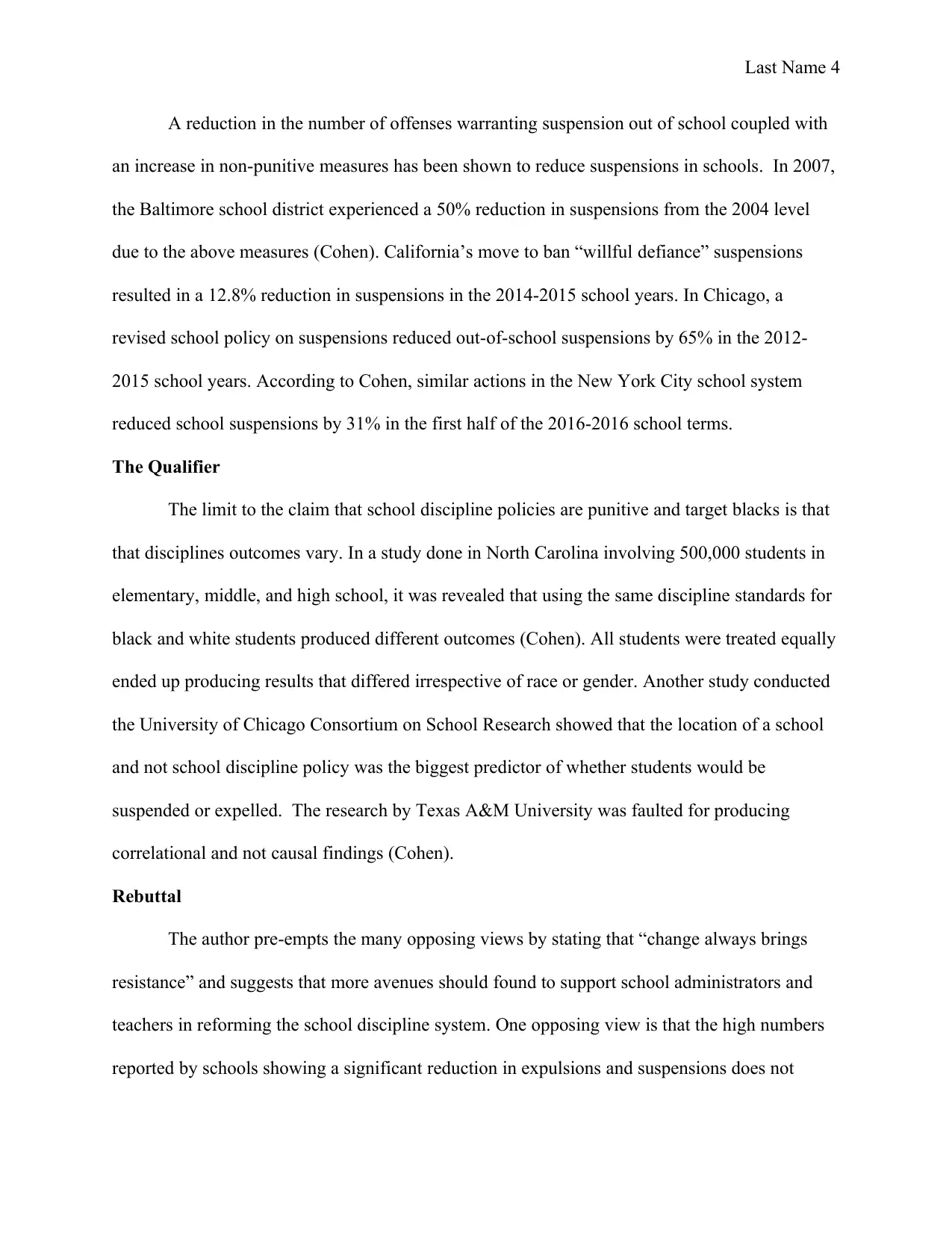
Last Name 4
A reduction in the number of offenses warranting suspension out of school coupled with
an increase in non-punitive measures has been shown to reduce suspensions in schools. In 2007,
the Baltimore school district experienced a 50% reduction in suspensions from the 2004 level
due to the above measures (Cohen). California’s move to ban “willful defiance” suspensions
resulted in a 12.8% reduction in suspensions in the 2014-2015 school years. In Chicago, a
revised school policy on suspensions reduced out-of-school suspensions by 65% in the 2012-
2015 school years. According to Cohen, similar actions in the New York City school system
reduced school suspensions by 31% in the first half of the 2016-2016 school terms.
The Qualifier
The limit to the claim that school discipline policies are punitive and target blacks is that
that disciplines outcomes vary. In a study done in North Carolina involving 500,000 students in
elementary, middle, and high school, it was revealed that using the same discipline standards for
black and white students produced different outcomes (Cohen). All students were treated equally
ended up producing results that differed irrespective of race or gender. Another study conducted
the University of Chicago Consortium on School Research showed that the location of a school
and not school discipline policy was the biggest predictor of whether students would be
suspended or expelled. The research by Texas A&M University was faulted for producing
correlational and not causal findings (Cohen).
Rebuttal
The author pre-empts the many opposing views by stating that “change always brings
resistance” and suggests that more avenues should found to support school administrators and
teachers in reforming the school discipline system. One opposing view is that the high numbers
reported by schools showing a significant reduction in expulsions and suspensions does not
A reduction in the number of offenses warranting suspension out of school coupled with
an increase in non-punitive measures has been shown to reduce suspensions in schools. In 2007,
the Baltimore school district experienced a 50% reduction in suspensions from the 2004 level
due to the above measures (Cohen). California’s move to ban “willful defiance” suspensions
resulted in a 12.8% reduction in suspensions in the 2014-2015 school years. In Chicago, a
revised school policy on suspensions reduced out-of-school suspensions by 65% in the 2012-
2015 school years. According to Cohen, similar actions in the New York City school system
reduced school suspensions by 31% in the first half of the 2016-2016 school terms.
The Qualifier
The limit to the claim that school discipline policies are punitive and target blacks is that
that disciplines outcomes vary. In a study done in North Carolina involving 500,000 students in
elementary, middle, and high school, it was revealed that using the same discipline standards for
black and white students produced different outcomes (Cohen). All students were treated equally
ended up producing results that differed irrespective of race or gender. Another study conducted
the University of Chicago Consortium on School Research showed that the location of a school
and not school discipline policy was the biggest predictor of whether students would be
suspended or expelled. The research by Texas A&M University was faulted for producing
correlational and not causal findings (Cohen).
Rebuttal
The author pre-empts the many opposing views by stating that “change always brings
resistance” and suggests that more avenues should found to support school administrators and
teachers in reforming the school discipline system. One opposing view is that the high numbers
reported by schools showing a significant reduction in expulsions and suspensions does not
Secure Best Marks with AI Grader
Need help grading? Try our AI Grader for instant feedback on your assignments.
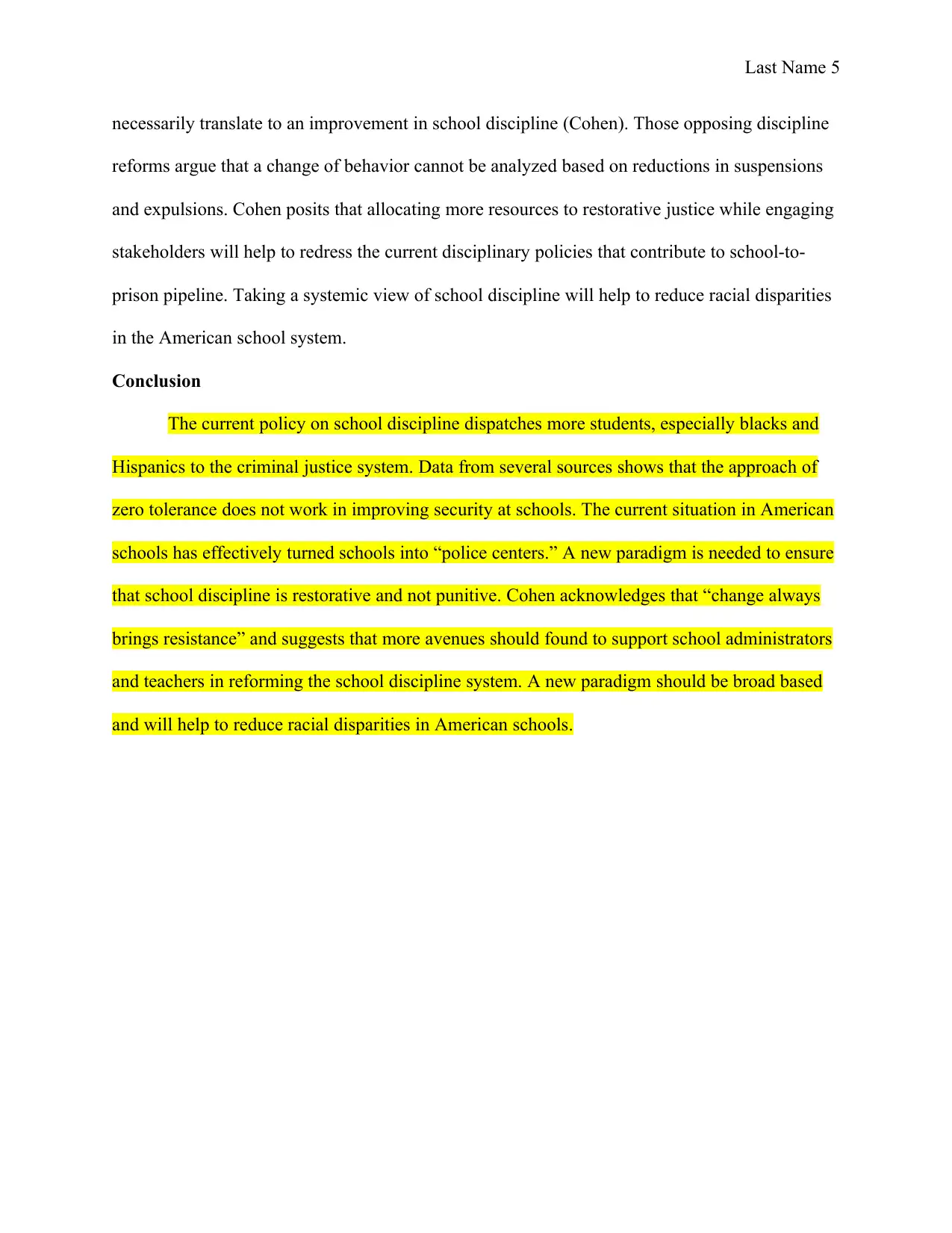
Last Name 5
necessarily translate to an improvement in school discipline (Cohen). Those opposing discipline
reforms argue that a change of behavior cannot be analyzed based on reductions in suspensions
and expulsions. Cohen posits that allocating more resources to restorative justice while engaging
stakeholders will help to redress the current disciplinary policies that contribute to school-to-
prison pipeline. Taking a systemic view of school discipline will help to reduce racial disparities
in the American school system.
Conclusion
The current policy on school discipline dispatches more students, especially blacks and
Hispanics to the criminal justice system. Data from several sources shows that the approach of
zero tolerance does not work in improving security at schools. The current situation in American
schools has effectively turned schools into “police centers.” A new paradigm is needed to ensure
that school discipline is restorative and not punitive. Cohen acknowledges that “change always
brings resistance” and suggests that more avenues should found to support school administrators
and teachers in reforming the school discipline system. A new paradigm should be broad based
and will help to reduce racial disparities in American schools.
necessarily translate to an improvement in school discipline (Cohen). Those opposing discipline
reforms argue that a change of behavior cannot be analyzed based on reductions in suspensions
and expulsions. Cohen posits that allocating more resources to restorative justice while engaging
stakeholders will help to redress the current disciplinary policies that contribute to school-to-
prison pipeline. Taking a systemic view of school discipline will help to reduce racial disparities
in the American school system.
Conclusion
The current policy on school discipline dispatches more students, especially blacks and
Hispanics to the criminal justice system. Data from several sources shows that the approach of
zero tolerance does not work in improving security at schools. The current situation in American
schools has effectively turned schools into “police centers.” A new paradigm is needed to ensure
that school discipline is restorative and not punitive. Cohen acknowledges that “change always
brings resistance” and suggests that more avenues should found to support school administrators
and teachers in reforming the school discipline system. A new paradigm should be broad based
and will help to reduce racial disparities in American schools.
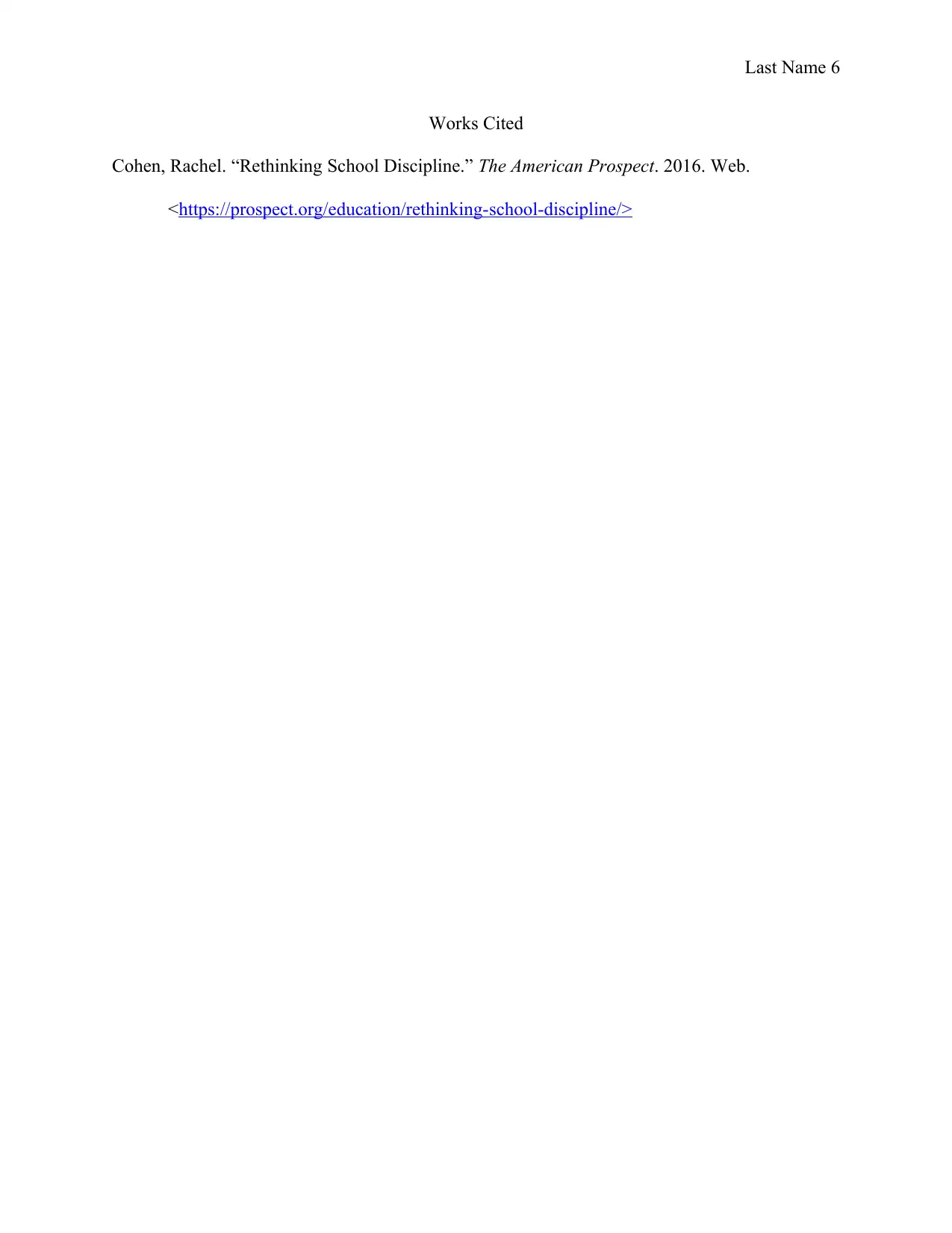
Last Name 6
Works Cited
Cohen, Rachel. “Rethinking School Discipline.” The American Prospect. 2016. Web.
<https://prospect.org/education/rethinking-school-discipline/>
Works Cited
Cohen, Rachel. “Rethinking School Discipline.” The American Prospect. 2016. Web.
<https://prospect.org/education/rethinking-school-discipline/>
1 out of 6
Your All-in-One AI-Powered Toolkit for Academic Success.
+13062052269
info@desklib.com
Available 24*7 on WhatsApp / Email
![[object Object]](/_next/static/media/star-bottom.7253800d.svg)
Unlock your academic potential
© 2024 | Zucol Services PVT LTD | All rights reserved.